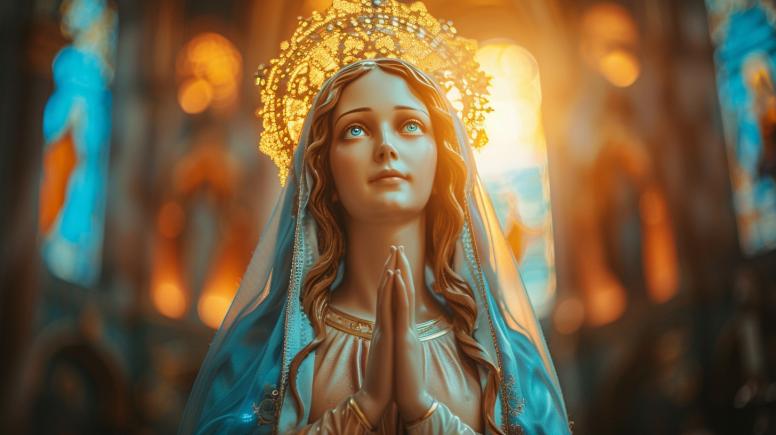At the heart of the Catholic faith, there is a singular devotion to Mary, an essential figure who transcends time. “Mary in the Catholic Faith: Understand her Role” is more than an invitation to theological understanding; it is a call to a deep understanding of the love and reverence dedicated to the mother of God. From the dogmas that ennoble her to her celebration in the daily lives of the faithful, this article unravels the cloak of mystery that surrounds Mary, leading you through a journey of faith, tradition and spirituality. Let's unfold the sacred pages and explore every facet of this devotion that shapes hearts and communities around the world.
Who is Mary in Catholic doctrine?
The main dogmas associated with Mary include her divine motherhood, the assumption and the immaculate conception. In Catholic doctrine, Mary is recognized as “mother of God” and also considered mother of the Church, a belief supported by her intimate relationship with Jesus Christ and her role in the plan of salvation. The importance of Mariology, which is the theological study of Mary, lies in its deepening and articulation of these truths, contemplating her unique participation in the history of salvation and her example of complete faith and obedience. As noted in Mother of God, Mariology not only deals with the dogmatic aspects, but also the cultural and devotional impact of the veneration of Mary in the lives of the faithful. In this way, Mary plays an incomparable role in the Catholic faith – as a model of holiness and intercessor before God.
How is Mary celebrated and venerated in Catholicism?
The main forms of Marian devotion in Catholicism involve praying the rosary, celebrating Marian festivals and participating in pilgrimages to shrines. The Church celebrates several Marian festivals throughout the year, such as the Immaculate Conception and the Assumption. The rosary, a meditation on the life of Christ through the eyes of Mary, is one of the most widespread spiritual practices. This reverence for Mary is deeply rooted in catholic faith. Mary is seen as the obedient mother of Jesus and a powerful intercessor for her children on Earth. Her life exemplifies total devotion to God, making her a model of faith and obedience for the faithful.
What are the most significant Marian apparitions and shrines?
Apparitions of Our Lady recognized by the Church include events in Guadalupe, Lourdes and Fátima. O Sanctuary of Fátima It is one of the most important pilgrimage sites, celebrating the apparitions of 1917, where thousands witnessed the “Miracle of the Sun”. Another highlight is the National Sanctuary of Our Lady of Aparecida, in Brazil, dedicated to the country's patron saint.
The importance of Marian shrines lies in their ability to bring together believers in faith and prayer, strengthening the Catholic community. They are places of great spiritual and cultural impact, where millions seek Mary's intercession. Sanctuaries and Marian apparitions have a profound impact on the Catholic faith, serving as places of healing, hope, and spiritual renewal.
What prayers and practices express devotion to Mary?
The main Catholic prayers dedicated to Mary include the “Hail Mary”, the “Rosary”, the “Hail Queen”, and the “Consecration to Our Lady”. These prayers reflect reverence for Mary and contemplate aspects of Jesus' life. The advocations of Our Lady, such as Our Lady of Fátima and Our Lady of Aparecida, describe the different representations of Mary and have great importance in religious practices, celebrating her apparitions and miracles in different cultural and local contexts. Marian intercession is a request for Mary to intermediary with God, seeking, through her closeness to Jesus, help in times of need and in the search for spiritual and temporal graces. In Mother of God, we can find more about how Catholic doctrine understands and honors Mary's intercessory role.
How is Mary presented in the Bible and theological literature?
What are the biblical references that talk about Mary?
Biblical references to Mary emphasize her presence especially in the Gospels of Matthew, Luke and the Acts of the Apostles. In such texts, she is described as the mother of Jesus, chosen by God for the birth of the Messiah, and presented as an example of faith and obedience.
How are Marian dogmas explained by Catholic theology?
You Marian dogmas They are pillars that explain the truths of faith regarding Mary, defined by the Catholic Church. They include her Immaculate Conception, her Perpetual Virginity, Divine Maternity and the Assumption of Mary into heaven, emphasizing her uniqueness and role in the history of salvation.
What are the main theological studies and discussions about the role of Mary?
Theological studies and discussions about Mary's role focus on her relevance within God's salvific plan, her relationship with the Trinity and intercession for the faithful. A Catholic theology extensively debates these points and looks at Mary as a supreme example of surrender to God, leading to profound reflections on Marian devotion in the life of the Church.
What is the cultural and social impact of devotion to Mary?
Mary exerts a notable influence on art, music and cultural traditions through her representation as the “Queen of Heaven” and through her “Immaculate Heart of Mary”. In numerous cultural expressions, Mary is seen as a source of inspiration and veneration. Her image is constant in popular iconography, from paintings to sculptures, and her presence is deeply felt in religious celebrations and local festivities, as exemplified by the devotion to “Our Lady of Guadalupe”.
A devotion to Mary it also transcends the strictly religious sphere, entering the social and cultural sphere of communities throughout the world. Celebrations such as processions and festivals not only unite people in faith but also in a shared sense of cultural identity. Thus, the figure of Mary has a role that goes beyond the spiritual, contributing to social cohesion and the enrichment of culture.
Mary in the Catholic Faith: Understand her Role
The importance of Mary in the Catholic Church is undeniable. Known as the mother of Jesus and, consequently, mother of God, she occupies an exceptional position at the heart of the Catholic faith. Beliefs about Mary are deeply rooted in Mariology, which is the theological study dedicated to her figure and her role in the divine plan.
What are the main dogmas associated with Mary? The central Marian dogmas are the Immaculate Conception and the Assumption. The first states that Mary was conceived without original sin, while the second believes that she was taken to heaven body and soul at the end of her earthly life.
How is Mary understood as mother of God and mother of the church? In Catholic doctrine, Mary is awarded the title of Theotokos, which literally means “God-bearer”. This title reinforces her position as the mother of God incarnate – not only the mother of the human Jesus, but also of the second person of the Holy Trinity. Mother of God.
How important is Mariology in Catholic theological study? Mariology serves to deepen the understanding of Mary's unique holiness, her intimate relationship with the Trinity, her participation in the plan of salvation and her example as a perfect disciple, all of this significantly reflecting on the experience of faith by the Catholic faithful.
In this article, we explore the various facets of Mary's relevance in the Catholic faith, from the dogmas that define her as mother of God and the Church to the devoted practices that express her veneration. The celebrations, sanctuaries and apparitions of Our Lady show her profound impact on both spirituality and culture. Through prayers and Mariology, we seek to better understand its unique role in Catholic theology, as well as its representation in the Bible and theological literature, without neglecting its influence on cultural and social traditions. Mary is undoubtedly a central figure who inspires faith, art and community, inviting us to look at the beauty and depth of her role in religious life and the cultural fabric that unites us.
FAQ
FAQ: Understanding the Role of Mary in Catholic Doctrine
What are the main dogmas associated with Mary in Catholic doctrine?
The main Marian dogmas include divine motherhood, the Immaculate Conception and the Assumption of Mary. These beliefs affirm Mary's purity and singular closeness to divinity.
How is Mariology important for Catholics?
Mariology is crucial for Catholics as it helps deepen understanding of Mary's unique role in salvation history, as well as her example of complete faith and obedience. Through this study, believers can reflect on the importance of Mary as mother of God and the Church.
What devotional practices to Mary are common in Catholicism?
In Catholicism, common devotional practices to Mary include praying the rosary, participating in Marian festivals, and making pilgrimages to shrines dedicated to her. These actions reflect the veneration and respect of the faithful for the mother of Jesus.
What is the meaning of the Marian apparitions for Catholics?
Marian apparitions have great significance for Catholics as they provide meeting points for prayer and strengthening faith. Locations such as Fátima and Lourdes are pilgrimage centers where believers seek Mary's intercession and experience spiritual renewal.
How does devotion to Mary impact society and culture?
Devotion to Mary impacts society and culture by influencing art, music and cultural traditions. Mary becomes a figure of cultural unity and identity, enriching cultural expressions and promoting social cohesion through religious festivities and celebrations.



